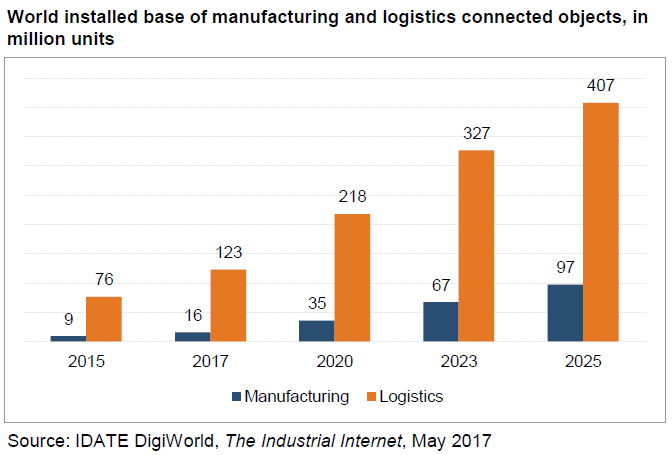|

This transformation is driven by enabling connectivity technologies (from LPWA to 5G) which contain disruptive features. These enable the connection of production tools, employees and finished products. A key challenge is to make sense of the connectivity, thus driving demand for analytics technologies, big data and artificial intelligence.
The trend brings real answers to industry demands:
First, the Industrial Internet is expected to bring productivity gains. Production optimisation takes many forms, from direct cost reduction through automation, increased efficiency through just-in-time, on-demand manufacturing, better integration of human resources, or increased flexibility through better communication and interconnection of the value chain. Productivity gains between 5 and 8% of total manufacturing costs are expected in mature economies.
Secondly, the Industrial Internet will enable the transformation of business models, which will have profound impacts on how the value chain is structured. Value is shifting from manufacturing activities towards R&D and design as well as pre- and after-sales services. New business models centred on manufacturing-as-a-service or product-as-a-service will develop. This trend also offers other opportunities such as breaking out of vertical industries (toward a platform model) or trying to harness the monetisation of data.
Acknowledged by the automation and engineering industry giants as a key transformation, and supported by different national and international initiatives such as Industry 4.0 or the Industrial Internet Consortium (IIC) the trend will develop strongly. Over 500 million manufacturing and logistics/supply chain objects should be connected by 2025, representing a CAGR of 19% over the 2015-2025 time frame.
For the trend to be fully adopted, will, however, take time. It requires commitment and investment by industry leaders (which will help demonstrate the return on investment), collaboration around standardisation initiatives, improvement of the security and reliability of technologies and dedicated efforts on labour skills and organisational changes.
The adoption will be progressive with some use cases already speeding up such as predictive maintenance or connected workforce, while others such as large scale production data analysis, value chain integration, connected end products or automation will take more time to develop. The actual demand for connected object will also be incremental as connectivity requirements will increase with the adoption of more advanced use cases.
The pattern of adoption will also vary among industries, as difference in technology awareness, regulation, cost sensitivity, but also demand for flexibility and potential for economies of scale varies. While industries such as automotive, consumer electronics or aerospace are well engaged, others such as process industries or textile will take longer to join the trend.
The adoption will also be uneven across regions. The Asia-Pacific region is leading and will lead all along the period followed by Europe, which will benefit from such initiatives as Industrie 4.0. The LATAM region will have the highest CAGR (21%) over the period under review.
|